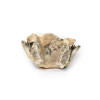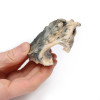Description
Clinical History
A 47-year-old male presents with a 13-month history of dysphonia and odynophagia at the level of his thyroid cartilage. He has a significant smoking history. Investigations revealed a laryngeal tumor. He received radiotherapy to the tumor followed by a laryngectomy. Six months later pulmonary metastases were discovered, and he subsequently died.
Pathology
This is the patient's laryngectomy specimen. The larynx has been sliced open and is viewed from the posterior aspect. There is significant right vocal cord distortion by an irregular ulcerating tumor. Mucosal congestion is also noted. Histologically this was a well differentiated squamous cell carcinoma (SCC).
Further Information
Over 95% of laryngeal cancers are SCC. The tumor usually develops on the vocal cords but may occur above or below the cords, on the epiglottis, aryepiglottic folds or in the pyriform sinuses. The cancer usually begins as carcinoma in situ, progressing to ulcerated and fungating carcinoma with continued exposure to carcinogens.
The greatest risk factors for developing cancer of the larynx are tobacco smoke and alcohol consumption. Human Papilloma Virus (HPV) infection, asbestos exposure and irradiation have also shown increased incidence. Males are affected more than females. It most frequently presents in the 6th decade of life.
Laryngeal cancer may spread by invading into surrounding structures, via lymphatics usually to local cervical nodes or hematogenous metastasis most commonly to the lungs. Common symptoms on presentation include dysphonia, dysphagia, odynophagia, globus and cough. Less commonly hemoptysis, stridor, dyspnoea and halitosis may be described. Treatment varies on the stage of the disease. Smoking and alcohol cessation are important for all disease stages. In early disease laryngeal preservation treatments may include laser therapy, microsurgery and radiotherapy. Later stage disease treatments may involve a combination of laryngectomy, radiotherapy and chemotherapy.
Advantages
- Anatomically accurate and identical to real specimen
- No ethical issues - not real human body parts
- Reasonably priced
- Available within a short lead time
- Reproducible, several identical prints can be used as a classroom set
- Can be produced in different sizes to cater for the needs of the teacher
Human Cadavers
- Access to cadavers can be problematic. Many countries cannot access cadavers for cultural and religious reasons
- Cadavers cost a lot money
- High cost for establishing your own plastination suite
- Wet specimens cannot be used in uncertified labs
- Dissection of cadavers is a lot of staff time and that is a cost
- Storage of cadaver material needs special refrigeration etc. which has coast
- If you want another specimen you have to start all over again
Plastinates
- Costs
- Ethical issues
- Timeframe for plastination process
- Many countries do not allow their importation
- One of a kind
Superior 3D print results compared with conventional methods
- Vibrant color offering with 10 million colors
- UV-curable inkjet printing
- High quality 3D printing that can create products that are delicate, extremely precise and incredibly realistic
Clear Support Material
- To avoid breakage of fragile, thin, and delicate arteries, veins or vessels, a clear support material is printed on such spots. This makes the models robust and can be handled by students easily.



























